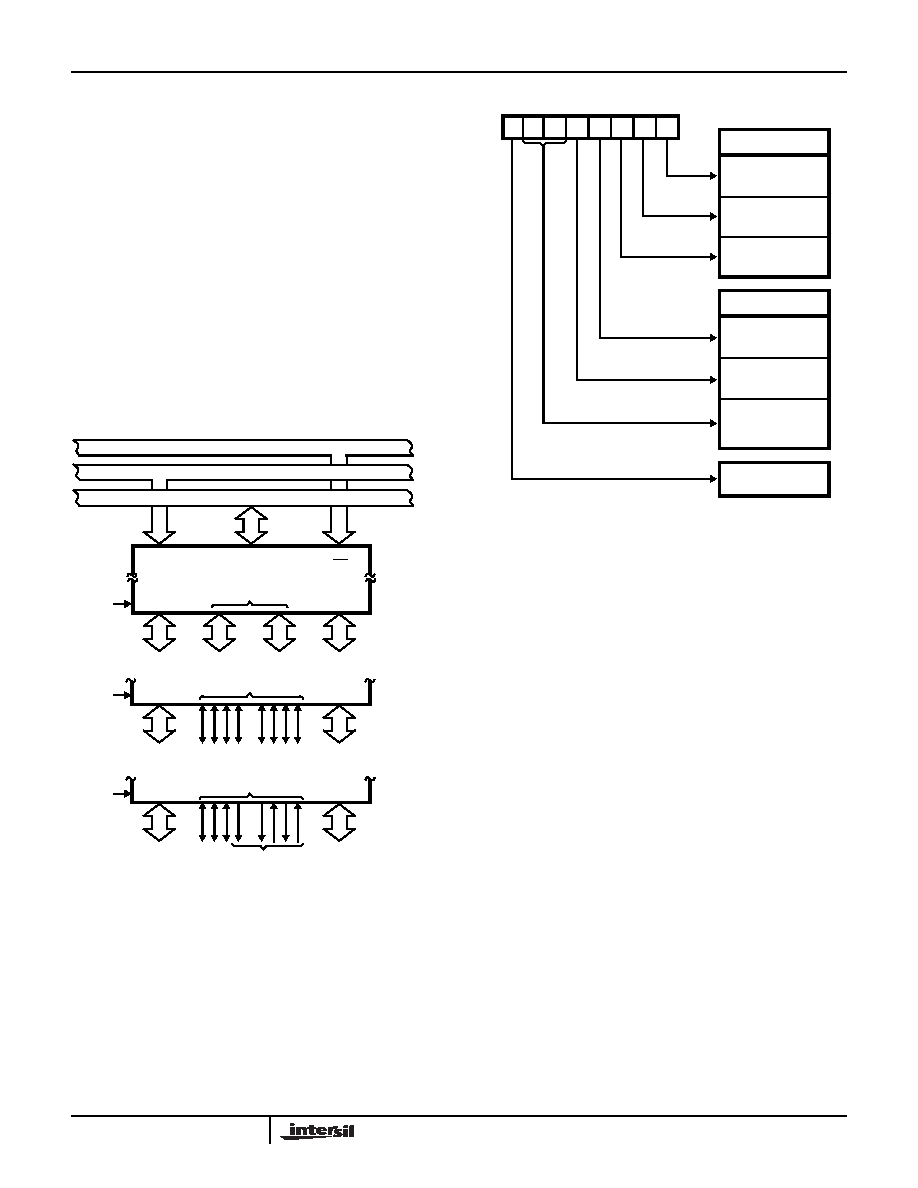- 您現(xiàn)在的位置:買賣IC網(wǎng) > PDF目錄3768 > CMQ82C55AZ (Intersil)IC I/O EXPANDER 24B 44MQFP PDF資料下載
參數(shù)資料
| 型號: | CMQ82C55AZ |
| 廠商: | Intersil |
| 文件頁數(shù): | 22/26頁 |
| 文件大小: | 0K |
| 描述: | IC I/O EXPANDER 24B 44MQFP |
| 標(biāo)準(zhǔn)包裝: | 960 |
| 接口: | 可編程 |
| 輸入/輸出數(shù): | 24 |
| 中斷輸出: | 無 |
| 電源電壓: | 4.5 V ~ 5.5 V |
| 工作溫度: | 0°C ~ 70°C |
| 安裝類型: | 表面貼裝 |
| 封裝/外殼: | 44-QFP |
| 供應(yīng)商設(shè)備封裝: | 44-MQFP(10x10) |
| 包裝: | 帶卷 (TR) |
第1頁第2頁第3頁第4頁第5頁第6頁第7頁第8頁第9頁第10頁第11頁第12頁第13頁第14頁第15頁第16頁第17頁第18頁第19頁第20頁第21頁當(dāng)前第22頁第23頁第24頁第25頁第26頁

5
FN6140.2
June 15, 2006
Operational Description
Mode Selection
There are three basic modes of operation than can be
selected by the system software:
Mode 0 - Basic Input/Output
Mode 1 - Strobed Input/Output
Mode 2 - Bidirectional Bus
When the reset input goes “high”, all ports will be set to the
input mode. After the reset is removed, the 82C55A can
remain in the input mode with no additional initialization
required. The control word register will contain 9Bh. During
the execution of the system program, any of the other modes
may be selected using a single output instruction. This
allows a single 82C55A to service a variety of peripheral
devices with a simple software maintenance routine. Any
port programmed as an output port is initialized to all zeros
when the control word is written.
The modes for Port A and Port B can be separately defined,
while Port C is divided into two portions as required by the
Port A and Port B definitions. All of the output registers,
including the status flip-flops, will be reset whenever the
mode is changed. Modes may be combined so that their
functional definition can be “tailored” to almost any I/O
structure. For instance: Group B can be programmed in
Mode 0 to monitor simple switch closings or display
computational results, Group A could be programmed in
Mode 1 to monitor a keyboard or tape reader on an interrupt-
driven basis.
The mode definitions and possible mode combinations may
seem confusing at first, but after a cursory review of the
complete device operation a simple, logical I/O approach will
surface. The design of the 82C55A has taken into account
things such as efficient PC board layout, control signal definition
vs. PC layout and complete functional flexibility to support
almost any peripheral device with no external logic. Such
design represents the maximum use of the available pins.
Single Bit Set/Reset Feature (Figure 5)
Any of the eight bits of Port C can be Set or Reset using a
single Output instruction. This feature reduces software
requirements in control-based applications.
When Port C is being used as status/control for Port A or B,
these bits can be set or reset by using the Bit Set/Reset
operation just as if they were output ports.
FIGURE 3. BASIC MODE DEFINITIONS AND BUS INTERFACE
DATA BUS
8I/O
B
PB7-PB0
4I/O
PC3-PC0
4I/O
C
PC7-PC4
8I/O
A
PA7-PA0
CONTROL BUS
ADDRESS BUS
RD, WR
82C55A
D7-D0
A0-A1
CS
MODE 0
8I/O
B
PB7-PB0
CONTROL
C
8I/O
A
PA7-PA0
MODE 1
OR I/O
CONTROL
OR I/O
8I/O
B
PB7-PB0
C
BI-
A
PA7-PA0
MODE 2
CONTROL
DIRECTIONAL
FIGURE 4. MODE DEFINITION FORMAT
D7 D6 D5
D4 D3 D2 D1 D0
PORT C (LOWER)
1 = INPUT
0 = OUTPUT
PORT B
1 = INPUT
0 = OUTPUT
MODE SELECTION
0 = MODE 0
1 = MODE 1
GROUP B
PORT C (UPPER)
1 = INPUT
0 = OUTPUT
PORT A
1 = INPUT
0 = OUTPUT
MODE SELECTION
00 = MODE 0
01 = MODE 1
GROUP A
1X = MODE 2
MODE SET FLAG
1 = ACTIVE
CONTROL WORD
MS82C55A, MQ82C55A, MP82C55A
相關(guān)PDF資料 |
PDF描述 |
|---|---|
| CMS82C55AZ96 | IC I/O EXPANDER 24B 44PLCC |
| CMS82C55AZ | IC I/O EXPANDER 24B 44PLCC |
| CS82C55A-5Z96 | IC I/O EXPANDER 24B 44PLCC |
| MCP2200-I/SO | IC USB TO UART 20SOIC |
| ATMEGA48-15MZ | MCU AVR 4K FLASH 15MHZ 32-QFN |
相關(guān)代理商/技術(shù)參數(shù) |
參數(shù)描述 |
|---|---|
| CMQ82C55AZ96 | 功能描述:外圍驅(qū)動器與原件 - PCI PERI PRG-I/O 5V 8MHZ COMOKIPLACEMENT RoHS:否 制造商:PLX Technology 工作電源電壓: 最大工作溫度: 安裝風(fēng)格:SMD/SMT 封裝 / 箱體:FCBGA-1156 封裝:Tray |
| CMR | 制造商:CRYDOM 制造商全稱:Crydom Inc., 功能描述:Crydoms CMR Series |
| CMR01G | 功能描述:LED 電路板指示器 HI EFF GREEN DIFF RIGHT ANGLE RoHS:否 制造商:Lumex LED 大小:3 mm 照明顏色:Green 波長:565 nm 光強(qiáng)度:30 mcd 安裝類型:SMD/SMT 顯示角:60 deg 封裝:Reel |
| CMR01R | 功能描述:LED 電路板指示器 HI EFF RED DIFFUSED RIGHT ANGLE RoHS:否 制造商:Lumex LED 大小:3 mm 照明顏色:Green 波長:565 nm 光強(qiáng)度:30 mcd 安裝類型:SMD/SMT 顯示角:60 deg 封裝:Reel |
| CMR01Y | 功能描述:LED 電路板指示器 YELLOW DIFFUSED RIGHT ANGLE RoHS:否 制造商:Lumex LED 大小:3 mm 照明顏色:Green 波長:565 nm 光強(qiáng)度:30 mcd 安裝類型:SMD/SMT 顯示角:60 deg 封裝:Reel |
發(fā)布緊急采購,3分鐘左右您將得到回復(fù)。